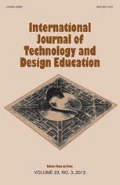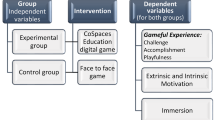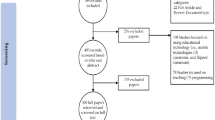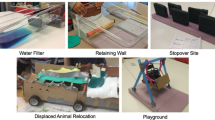Abstract
In higher education effective teaching includes making learning goals and standards clear to students. In architecture and design education in particular, goals and standards around assessment are often not well articulated. There is good evidence that when teachers engage students before an assessment in marking exemplars, and explain why the exemplars received the grades they did, students’ performance in their written assessment is consequently enhanced. However some teachers are concerned that exemplars may discourage students from being creative; this concern is particularly important in design education. In this small-scale mixed methods study we explore interaction design students’ perceptions of the effect of an exemplar-based teaching approach on their work in a design task. Our quantitative and qualitative results show that students developed their understanding of task criteria and standards; far from discouraging their creativity, most students perceived that their experience of the approach enhanced their awareness of the need to produce an original design. The exemplar-based approach used in this study complements the studio-based teaching approach in design education, and helps to make clear the design goals and standards that teachers expect their students to strive for.
Similar content being viewed by others
References
Barrie, S., Ginns, P., & Prosser, M. (2005). Early impact and outcomes of an institutionally aligned, student focused learning perspective on teaching quality assurance. Assessment & Evaluation in Higher Education, 30(6), 641–656.
Bloxham, S., & Boyd, P. (2007). Developing effective assessment in higher education: A practical guide. Maidenhead: Open University Press.
Braun, V., & Clarke, V. (2006). Using thematic analysis in psychology. Qualitative Research in Psychology, 3(2), 77–101.
Brown, S., & Knight, P. (2004). Assessing learners in higher education. Abingdon: RoutledgeFalmer.
Burnard, P. (2004). Writing a qualitative research report. Nurse Education Today, 24, 174–179.
Carless, D., Joughin, G., & Liu, N. (2006). How assessment supports learning: Learning-oriented assessment in action. Hong Kong: Hong Kong University Press.
Cowdroy, R., & William, A. (2006). Assessing creativity in the creative arts. Art Design and Communication in Higher Education, 5(2), 97–117.
Devlin, M., & Samarawickrema, G. (2010). The criteria of effective teaching in a changing higher education context. Higher Education Research and Development, 29(2), 111–124.
Dowden, T., Pittaway, S., Yost, H., & McCarthy, R. (2013). Students’ perceptions of written feedback in teacher education: Ideally feedback is a continuing two-way communication that encourages progress. Assessment & Evaluation in Higher Education, 38(3), 349–362.
Eshun, E. F., & Osei-Poku, P. (2013). Design students’ perspectives on assessment rubric in studio-based learning. Journal of University Teaching & Learning Practice, 10(1), 1–13.
Hendry, G. D., & Anderson, J. (2013). Helping students understand the standards of work expected in an essay: Using exemplars in mathematics pre-service education classes. Assessment and Evaluation in Higher Education, 38(6), 754–768.
Hendry, G. D., Armstrong, S., & Bromberger, N. (2012). Implementing standards-based assessment effectively: Incorporating discussion of exemplars into classroom teaching. Assessment and Evaluation in Higher Education, 37(2), 149–161.
Hendry, G. D., Bromberger, N., & Armstrong, S. (2011). Constructive guidance and feedback for learning: The usefulness of exemplars, marking sheets and different types of feedback in a first year law subject. Assessment and Evaluation in Higher Education, 36(1), 1–11.
McConlogue, T. (2012). But is it fair? Developing students’ understanding of grading complex work through peer assessment. Assessment and Evaluation in Higher Education, 37(1), 113–123.
Nulty, D. D. (2008). The adequacy of response rates to online and paper surveys: What can be done? Assessment and Evaluation in Higher Education, 33(3), 301–314.
Payne, E., & Brown, G. (2011). Communication and practice with examination criteria. Does this influence performance in examinations? Assessment and Evaluation in Higher Education, 36(6), 619–626.
Petty, G. (2009). Evidence-based teaching: A practical approach. Cheltenham: Nelson Thorne.
Price, M., Handley, K., Millar, J., & O’Donovan, B. (2010). Feedback: All that effort, but what is the effect? Assessment and Evaluation in Higher Education, 35(3), 277–289.
Price, M., Rust, R., O’Donovan, B., Handley, K., & Bryant, R. (2012). Assessment literacy: The foundation for improving student learning. Oxford: OCSLD.
Ramsden, P. (2003). Learning to teach in higher education. London: RoutledgeFarmer.
Sadler, D. R. (2009). Grade integrity and the representation of academic achievement. Studies in Higher Education, 34(7), 807–826.
Smith, C. D., Worsfold, K., Davies, L., Fisher, R., & McPhail, R. (2013). Assessment literacy and student learning: The case for explicitly developing students ‘assessment literacy’. Assessment and Evaluation in Higher Education, 38(1), 44–60.
Williams, A., & Askland, H. H. (2012). Assessing creativity: Strategies and tools to support teaching and learning in architecture and design. Sydney, NSW: Office for Learning and Teaching. Retrieved from URL http://www.olt.gov.au/system/files/resources/PP9_1288_Williams_Report_2012.pdf.
Wimshurst, K., & Manning, M. (2013). Feed-forward assessment, exemplars and peer marking: Evidence of efficacy. Assessment and Evaluation in Higher Education, 38(4), 451–465.
Author information
Authors and Affiliations
Corresponding author
Appendix: Perceptions of marking design project exemplars questionnaire
Appendix: Perceptions of marking design project exemplars questionnaire
Marking the example design projects on my own
-
1.
I made an effort to mark the design projects using the assessment criteria
-
2.
The assessment criteria were easy to understand when I was marking the example design projects
-
3.
The assessment criteria became easier to understand when I was marking the example design projects
-
4.
I found marking the example design projects difficult
Please tell us more
Discussing the example design projects in my group in class
-
5.
During our group discussion I learned that my peers’ views about the quality of the example design projects differed
-
6.
I found discussing the example design projects in my group challenging
Listening to the teacher’s explanation
-
7.
The teacher’s explanation of how they graded the example design projects was useful
-
8.
The teacher made it clear what was expected for a well-designed project
-
9.
My judgements about the quality of the example design projects were confirmed by the teacher
-
10.
The assessment criteria were easier to understand after the teacher explained how they graded the example design projects
-
11.
I was able to relate the teacher’s explanation of the way the example design projects were designed to the way I would approach the design process
-
12.
I found the teacher’s explanation of how they graded the example design projects challenging
Please tell us more
Using the example design projects
-
13.
The example design projects showed me how to start my project
-
14.
Seeing the examples of design projects made it hard for me to be creative in my project
Overall
-
15.
Marking the example design projects and the group discussion and teacher explanation was useful for starting my project
-
16.
Marking the example design projects and the group discussion and teacher explanation led me to think about the quality of work I wanted to achieve with my project
-
17.
Marking the example design projects and the group discussion and teacher explanation gave me confidence to be able to do well in my project
-
18.
From marking the example design projects and the group discussion and teacher explanation I learned about the qualities of a good project
-
19.
I modelled the design of my project on the example of a good project
-
20.
I am able to apply what I learned about well-designed projects to the design process in other units of study
-
21.
Please rank from 1 to 3 the usefulness for your learning of the following activities, where 1 is most useful and 3 is least useful:
Marking the example design projects on my own
Discussing the example design projects in class with other students
Listening to the teacher explain how they graded the example design projects
-
22.
Please tell us why the first ranked activity was most useful
Rights and permissions
About this article
Cite this article
Hendry, G.D., Tomitsch, M. Implementing an exemplar-based approach in an interaction design subject: enhancing students’ awareness of the need to be creative. Int J Technol Des Educ 24, 337–348 (2014). https://doi.org/10.1007/s10798-013-9256-6
Accepted:
Published:
Issue Date:
DOI: https://doi.org/10.1007/s10798-013-9256-6




